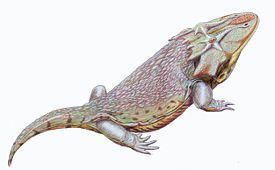Kingdom Animalia Superfamily †Eryopoidea Rank Family | Order †Temnospondyli Phylum Chordata | |
 | ||
Similar Zatrachys, Dasyceps, Onchiodon | ||
Zatrachydidae (sometimes mistakenly spelled Zatracheidae) is a family of Late Carboniferous and Early Permian temnospondyl amphibians known from North America and Europe. Zatrachydids are distinguished by lateral (sideways) bony protuberances of the quadratojugal bone of the skull, and a large opening in the palate. The skull is flattened, with small orbits or eye sockets set far back. The opening in the palate may have housed a gland for producing a sticky substance so that prey would adhere to the tongue. If so, this indicates that these animals spent a large part of their time on land.
Development
Zatrachydids are one of several temnospondyl groups that are known to have undergone metamorphosis from young to adult. The first named zatrachydid, Zatrachys, is known from several large adult specimens with large spikes and an extensive covering of pits and grooves on its skull. Another zatrachydid, Acanthostomatops, is known from both adult and larval specimens. The smallest larvae each have three pairs of ceratobranchial bones behind their skulls, which would have supported gills. They have unusually well-developed vertebrae with ossified centra. Larvae have rounded skulls with smooth margins. Spikes developed during metamorphosis, and as zatrachydids continued growing as adults, the pits and grooves on their skulls grew more extensive and the otic notch at the back of the skull grew wider. These notches likely supported membranes called tympana, which serve as ear drums in living amphibians. The choanae also grew larger during metamorphosis, and are distinguished by their irregular shape, which differs from the more circular shape seen in other temnospondyls. Zatrachydids also possess a hole in the center of their palates called the inter-vomerine fontanelle, which grows larger during metamorphosis. This hole is seen in living salamanders and frogs and is associated with an organ called the intermaxillary gland, which produces secretions that make the tongue sticky. It may also have been present in zatrachydids.
